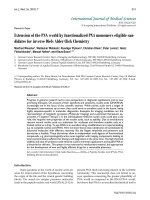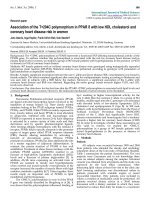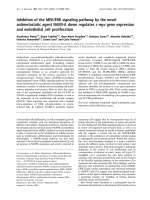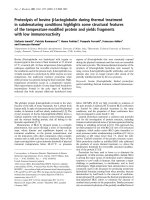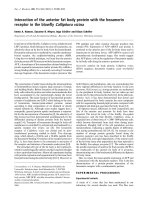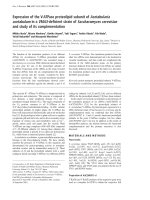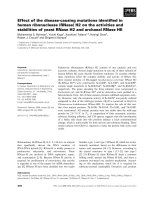Báo cáo y học: "Expression of hMSH2 protein of the human DNA mismatch repair system in oral lichen planus"
Bạn đang xem bản rút gọn của tài liệu. Xem và tải ngay bản đầy đủ của tài liệu tại đây (676.23 KB, 6 trang )
Int. J. Med. Sci. 2004 1(3): 146-151
146
International Journal of Medical Sciences
ISSN 1449-1907 www.medsci.org 2004 1(3): 146-151
©2004 Ivyspring International Publisher. All rights reserved
Expression of hMSH2 protein of the human DNA mismatch
repair system in oral lichen planus
Research paper
Received: 2004.4.27
Accepted: 2004.6.28
Published: 2004.8.05
Flávio Juliano Garcia Santos Pimenta
1
, Maria das Graças Rodrigues Pinheiro
2
, Ricardo
Santiago Gomez
1
1
Department of Oral Surgery and Pathology, School of Dentistry, Universidade Federal de
Minas Gerais, Belo Horizonte, Brazil.
2
School of Dentistry, Centro de Ensino Superior do Pará, Belém, Brazil.
A
A
b
b
s
s
t
t
r
r
a
a
c
c
t
t
Lichen planus is a mucocutaneous disease of inflammatory nature and
unknown etiology. It is characterized by a cell-mediated immunological
response to induced antigenic change in skin and/or mucosa. The possible
malignant transformation of lichen planus remains a subject of controversial
discussions in the literature. hMSH2 is one of the human DNA mismatch
repair (hMMR) genes and it plays an important role in reducing mutation
and maintaining genomic stability. hMSH2 alterations have been reported in
oral squamous cell carcinoma and there are evidences suggesting the
association between oral lichen planus and squamous cell carcinoma. In this
study, we aim to investigate the immunolocalization of hMSH2 protein in
oral lichen planus compared to oral normal mucosa epithelium. We
examined the expression of hMSH2 protein by immunohistochemistry in
twenty-six cases of oral lichen planus. Clinically, 12 of them were categorized
into reticular subtype and 14 were atrophic/erosive. Ten cases of normal
mucosa were added to the control group. Results showed that the percentage
of positive cells to hMSH2 was smaller in reticular (46.54%; p=0,006) and
atrophic/erosive (48.79%; p=0,028) subtypes of oral lichen planus compared
to normal mucosa (61.29%). The reduced expression of hMSH2 protein in
oral lichen planus suggests that this lesion is more susceptible to mutation
and therefore facilitate the development of oral squamous cell carcinoma.
K
K
e
e
y
y
w
w
o
o
r
r
d
d
s
s
hMSH2, immunohistochemistry, oral lichen planus and malignant
transformation
A
A
u
u
t
t
h
h
o
o
r
r
b
b
i
i
o
o
g
g
r
r
a
a
p
p
h
h
y
y
Flávio Juliano Garcia Santos Pimenta, DDS, is pursuing postgraduate study at the School
of Dentistry, Universidade Federal de Minas Gerais. His research interests include molecular
analysis of genes associated with oral diseases. His current work is in the analysis of wwox
gene in oral cancer.
Maria das Graças Rodrigues Pinheiro, DDS, has concluded her MS at the School of
Dentistry, Universidade Federal de Minas Gerais and is lecturer at Centro de Ensino Superior
do Pará (CESUPA), Belém. Her research interests include radiographic investigation of oral
diseases. Her current work is in radiographic analysis of odontogenic tumors.
Ricardo Santiago Gomez, DDS MS PhD, is Professor in Oral Pathology and Director of
School of Dentistry, Universidade Federal de Minas Gerais and research fellow of Conselho
Nacional de Desenvolvimento Científico e Tecnológico. His research interests include
molecular analysis of genes associated with oral diseases. He currently works on
investigating the association between polymorphism of genes and susceptibility to oral
diseases.
C
C
o
o
r
r
r
r
e
e
s
s
p
p
o
o
n
n
d
d
i
i
n
n
g
g
a
a
d
d
d
d
r
r
e
e
s
s
s
s
Prof. Ricardo Santiago Gomez, Departamento de Patologia e Cirurgia, Faculdade de
Odontologia, Universidade Federal de Minas Gerais, Av. Antonio Carlos, 6627, Belo
Horizonte – MG, Brasil CEP 31270901, e-mail:
Int. J. Med. Sci. 2004 1(3): 146-151
147
1. Introduction
Lichen planus is a chronic inflammatory mucocutaneous disease of unknown etiology that
frequently involves the oral mucosa. The disease affects skin and mucosa in prevalence estimated
between 0.5 and 2.0% of the population with predilection for females and a mean age at onset in the
fourth or fifth decade [1]. Lichen planus affects the oral mucosa and lesions may occur without skin
lesions. About half of the patients with skin lesions have oral lesions, whereas about 25% present with
oral lesions alone [2].
Oral lichen planus (OLP) may present anywhere in the oral cavity. The buccal mucosa, tongue and
gingival are the most common sites, whereas palatal lesions are uncommon [3]. They are usually
symmetrical and bilateral lesions or multiple lesions may occur in the mouth [4]. OLP can appear
clinically in at least six forms that can occur separately or simultaneously: reticular, papular, plaque,
atrophic, erosive and bullous [2]. The reticular, papular, plaque-like forms are usually painless and
appear clinically as white keratotic lesions. The erosive, atrophic and bullous forms are often associated
with a burning sensation and in many cases can cause severe pain [5].
The possible malignant transformation of OLP is a subject of controversial discussion in the
literature. While some studies support a premalignant nature of OLP [6,7], others argue against the
validity of this statement [8,9]. It has been reported that the actual overall frequency of OLP malignant
transformation varies between 0.3 and 12.5% [6,9]. Analysis of the published data is difficult because
of differences in diagnostic criteria, time to follow-up and information on exposure to known oral
carcinogens [10]. The diagnostic criteria are major problem as there is no accepted standard [9].
Whether cancer development is part of the natural evolution of OLP lesions or is due to extrinsic factors
is unknown [11]. However, the association between chronic inflammation with a variety of epithelial
malignancies has been recognized [12]. There is now enough evidence to suggest that the inflammatory
cells and cytokines found in peri-tumoural stroma can contribute to tumor development and progression
rather than mount an effective host antitumor response [12].
The human DNA mismatch repair (hMMR) system plays an important role in reducing mutation
and maintaining genomic stability. It corrects base-base mismatches and short insertions/deletions
generated as a consequence of DNA replication errors and homologous recombination [13]. MMR
genes, including hMSH2, hMLH1, hMSH3, hMPS1, hPMS2 and GTBP/hMSH6 are very important in
distinguishing and repairing misparing and slippage errors in DNA synthesis. The mismatch is detected
by two complexes, the hMSH2-GTBP/hMSH6 and the hMSH2-hMSH3 heterodimers after interaction
with hMLH1-hPMS2 heterodimers, an endonuclease is activated and incises the newly synthesized
DNA strand that contains the mutation [14]. Immunohistochemical study on non-polyposis colorectal
cancer demonstrated no expression of hMSH2 gene in the tumoral cells [15]. With regard to sporadic
forms of tumors, reduced expression of hMSH2 have been reported in a distinct subset of oral and neck
squamous cell [16], colorectal [17], endometrial [18], ovarian [19] and urinary bladder carcinomas [20].
As hMSH2 alterations have been reported in oral squamous cell carcinoma and there are evidences
suggesting the association between oral lichen planus and squamous cell carcinoma, in this study, we
aim to investigate the immunolocalization of hMSH2 protein in oral lichen planus compared to oral
normal mucosa epithelium.
2. Materials and Methods
Tissue Samples
The material and methods have been approved by the ethical committee of Universidade Federal
de Minas Gerais. Twenty-six samples of OLP diagnosed on clinical and histological criteria [21] were
retrieved from the files of the Oral Pathology Service, Universidade Federal de Minas Gerais. Twelve
OLP (six females and six males; age range from 27 to 61 years) were reticular clinical subtypes and 14
were atrophic/erosive OLP (eight females and six males; age range from 19 to 65 years). Ten samples
of oral normal mucosa were included in the control group (six males and four females; age range from 8
to 67 years).
Immunohistochemical Method
Int. J. Med. Sci. 2004 1(3): 146-151
148
The hMSH2 protein staining was performed by the LSAB kit (DAKO, Carpinteria, USA). Briefly,
3 µm sections were dewaxed in xylene and hydrated with graded ethanol. Removal of formolic
pigment was performed. Endogenous peroxidase was blocked by incubating sections in 6% (v/v)
H
2
O
2
/methanol. Slides were placed in 10mM citrate buffer (pH 6.0) and heated to 96°C in a steamer for
30 minutes and incubated with the primary antibody for 18 h at room temperature. The primary serum
used were anti-hMSH2 (Clone G219-1129, Pharmingen, San Diego, USA) diluted 1:100 in 20 mmol/L
Tris-HCl buffer (ph 7.4) containing 0.9% NaCl. After washing in the Tris-HCl buffer, sections were
incubated for 30 min at room temperature with biotinylated multi-link swine anti-goat, mouse and
rabbit immunoglobulin. Sections were washed and incubated for 30 min at room temperature with
prediluted streptavidin-peroxidase conjugated. The peroxidase activity was visualized by applying
0.01% diaminobenzidine tetrahydrochloride and 0.03% H
2
O
2
. Sections were counterstained with
Meyer’s haematoxylin and mounted in Permount
TM
. Negative controls consisted of omission of the
primary or the secondary antibody or primary incubation in the presence of non-immunized rabbit
serum instead of the primary antibody.
Cell quantification and Statistical analysis
The immunolocalization of hMSH2 was quantitatively analyzed. Epithelial cells were considered
to be positive if there was any staining of the nucleus, regardless of staining intensity. Cell counting was
performed in six high-power microscopic fields (400x, Standard 20, ZEISS), which comprised almost
all of the OLP epithelium. The count was performed by two investigators without knowledge of
whether the samples were control or experimental. The total number of basal and suprabasal epithelial
cells along the six microscopic fields and the number of basal and suprabasal cells stained to hMSH2
protein were assessed. The percentage of cells stained to hMSH2 was obtained to each sample. As
percentage does not conform normal distribution, the Mann-Whitney Test was used for statistical
analysis. The values were considered significantly different when the p value was less than 0.05.
3. Results
The hMSH2 immunoreativity was detected mainly in basal and intermediate epithelial layers (Fig.
1 and 2). The mean percentage of positive epithelial cells to hMSH2 in OLP and oral normal mucosa
were listed in table 1. The percentage of positive cells in reticular and atrophic/erosive subtypes of OLP
was significantly decreased compared to oral normal mucosa (Table 1). No difference was detected
between the reticular and atrophic/erosive subtypes.
4. Discussion
Several conditions in oral pathology have been characterized as premalignant and many factors
have been considered to promote the development of carcinoma in the oral cavity. An important
question still relates to the precancerous potential of oral lichen planus [22]. Most studies have shown
that patients with OLP develop oral cancer at an increased rate as compared with the general population
[4,7,11]. Many articles are found in the literature suggesting an association of lichen planus to oral
squamous cell carcinoma, but several of them suffer from poor documentation. The most common
errors resulting in misleading conclusions are: the initial diagnostic errors, the inclusion of cases that
had a known history of exposure to recognized carcinogens, and the report of cases of lichenoid
dysplasia as malignant transformation of lichen planus. Despite differences in experimental designs, the
majority of studies have reported a rate of malignant transformation of OLP between 0.5 and 2% over
five-year period [23].
OLP is a T-cell-mediated chronic inflammatory disorder of unknown etiology. Histopathologically
it is characterized by a sub-epithelial lymphocytic infiltrate, disruption of epithelial basement
membrane, degeneration of basal keratinocytes, hyperkeratinization and acanthosis [24]. Basal cells are
the prime target of destruction in OLP. The mechanism of basal cell damage is related to a cell-
mediated immune process involving Langerhans cells, T lymphocytes and macrophages [5]. The
majority of OLP-related T-cells are activated cytotoxic CD8
+
T-cells, which are known to trigger
keratinocyte apoptosis via TNF-alpha release [25].
The association between chronic inflammation with a variety of epithelial malignancies has been
recognized. Examples of well known association between inflammation and cancer risk include,
inflammatory bowel diseases and colorectal cancer, atrophic gastritis and gastric cancer, gall bladder
Int. J. Med. Sci. 2004 1(3): 146-151
149
cancer related to chronic cholecyistitis, and esophageal carcinoma after reflux esophagitis [12]. There is
now enough evidence to suggest that in some instances inflammatory cells and cytokines found in
peritumoral stroma can more likely contribute to tumor development and progression than to mount an
effective host antitumoral response [12]. Recent studies have focused on the stromal inflammatory
environment before the malignant lesions appear, and have underlined its active role during the
transition from normal tissue to in situ and invasive carcinoma [26]. Stromal cells and their products, in
association with insoluble intracellular matrix components, can act as an oncogenic agent, causing the
disruption of homeostatic regulation of adjacent cells, such as tissue architecture, cell death and
proliferation, and leading to the development of solid neoplasia, such as breast, colon and prostate
carcinoma [27]. Additional studies are necessary to establish whether OLP could be classified among
these chronic disorders. Many inflammatory factors known to be related with cancer initiation,
progression, and invasion are also expressed by OLP-related chronic inflammatory infiltrate, and thus
may contribute to OLP malignant transformation [24].
hMSH2 is especially expressed in human cells that are undergoing rapid renewal: in the lower-two
thirds of gastrointestinal glands [15], in the more primitive testicular germ cells [28], in the transitional
epithelial cells of the bladder [20], and in the basal cell line of epidermis and oral mucosa [29].
Inactivation of hMSH2, one of the most commonly hMMR genes, is a described alternative pathway in
cancer development and progression. The resulting genetic instability is characterized by somatic
mutations in repetitive sequences of tumor DNA and is termed microsatellite instability [13]. Although
described in a variety of tumors [17-20], hMMR deficiency has been studied predominantly in
colorectal carcinomas. A distinct proportion of sporadic (and almost all hereditary) non-polyposis
colorectal cancers exhibit hMSH2 gene alterations. These tumors show high frequency of microsatellite
instability and are immunohistochemically characterized by the lack of hMSH2 protein expression [15].
Moreover, Lo Muzio et al. [29] reported that 5% of the cases of oral squamous cell carcinoma show
diminished expression of hMSH2 protein.
In the present study, we demonstrated decreased expression of hMSH2 protein in reticular and
atrophic/erosive OLP compared to oral normal mucosa. This reduction probable occurred by the
destruction of basal layer provoked by immune response. da Silva Fonseca & do Carmo [30] showed
that OLP kerationocytes present higher PCNA index and AgNOR numbers than epithelial cells from
normal mucosa, which suggests increased cellular proliferation in OLP. As DNA damage is more prone
to occur during the cell cycle, it can be assumed that a higher index of cellular proliferation in OLP
would require an increased immunolocalization of hMSH2. Therefore, the reduced expression of
hMSH2 protein could make the epithelium of OLP more susceptible to DNA mutation, making it prone
to oral squamous cell carcinoma development. Further studies are necessary to confirm this hypothesis.
Acknowledgments
This investigation was supported in part by grants from FAPEMIG, PRONEX and CNPq, Brazil.
Dr. Gomez RS is research fellow of CNPq.
Conflict of interest
The authors have declared that no conflict of interest exists.
References
1. Scully C, El-Korm M. Lichen planus: review and update on pathogenesis. J Oral Pathol 1985; 14:431-58.
2. Andreansen JO. Oral lichen planus: a clinical evaluation of 115 cases. Oral Surg Oral Med Oral Pathol 1968;
25:31-42.
3. Jungell P. Oral lichen planus: a review. Int J Oral Maxillofac Surg 1991; 20:129-35.
4. Silverman S, Grosky M, Lozada-Nur F, Giannoti K. A prospective study of findings and management in 214
patients with oral lichen planus. Oral Surg Oral Med Oral Pathol 1991; 72:665-70.
5. Mollaoglu N. Oral lichen planus. Br J Oral Maxillofac Surg 2000; 38:370-7.
6. Lo Muzio L, Mignona MD, Favia G, Procaccini M, Testa NF, Bucci E. The possible association between
oarl lichen planus and oral squamous cell carcinoma: a clinical evaluation on 14 cases and a review of the
literature. Oral Oncol 1998; 34:239-46.
7. Mignona MD, Lo Muzio L, Lo Russo L, Fedele S, Ruoppo E, Bucci E. Clinical guidelines in early detection
of oral squamous cell carcinoma arising in oral lichen planus: a 5-year experience. Oral Oncol 2001; 37:262-
7.
Int. J. Med. Sci. 2004 1(3): 146-151
150
8. Allen CM. Oral lichen planus: a premalignant disease? Pathol Case Rev 1999; 4:35-9.
9. Van der Meij EH, Schepman KP, Smeele LE, Van der Wal JE, Bezemer PD, Van der Wal I. A review of the
recent literature regarding malignant transformation of oral lichen planus. Oral Surg Oral Med Oral Pathol
1999; 88:307-10.
10. Gandolfo S, Richiardi L, Carrozzo M, Broccoletti R, Carbone M, Pagano M, Vestita C, Rosso S, Merletti F.
Risk of oral squamous cell carcinoma in 402 patients with oral lichen planus: a follow-up study in an Italian
population. Oral Oncol 2004; 40:77-83.
11. Holmstrup P, Thorn JJ, Rindum J, Pindborg JJ. Malignant development of lichen planus-affected oral
mucosa. J Oral Pathol 1988; 17:219-25.
12. Balkwill F, Mantovani A. Inflammation and cancer: Back to Virchow? The Lancet 2001; 357: 539-45.
13. Kolodner R. Biochemistry and genetics of eukaryotic mismatch repair.
Genes Dev 1996; 15: 1433-42.
14. Bellacosa A, Cicchilliti L, Schepis F Riccio A, Yeung AT, Matsumoto Y, Golemis EA, Genuardi M, Neri G.
MED1, a novel humam methyl-CpG-binding endonuclease, interacts with DNA mismatch repair protein
MLH1. Proc Natl Acad Sci USA 1999; 96: 3969-74.
15. Leach FS, Polyak K, Burell M, Johnson KA, Hill D, Dunlop MG, Wyllie AH, Peltomaki P, Chapelle A,
Hamilton SR, Kinzler KW, Vogelstein B. Expression of the human mismatch gene hMSH2 in normal and
neoplastic tissues. Cancer Research 1996; 56:235-40.
16. Nunn J, Nagini S, Risk JM, Prime W, Maloney P, Liloglou T, Jones AS, Rogers SR, Gosney JR, Woolgar J,
Field JK. Allelic imbalance at the DNA mismatch repair loci, hMSH2, hMLH1, hPMS1, hPMS2 and hMSH3,
in squamous cell carcinoma of the head and neck. Oral Oncology 2003; 39:115-29.
17. Thibodeau SN, French AJ, Roche PC, Cunningham JM, Tester DJ, Lindor NM, Moslein G, Baker SM,
Liskay RM, Burgart LJ, Honchel R, Halling KC. Altered expression of hMSH2 and hMLH1 in tumors with
microsatellite instability and genetic alterations in mismatch repair genes. Cancer Research 1996; 56: 4836-
40.
18. Katabuki H, van Rees B, Lambers AR, Ronnett BM, Blazes MS, Leach FS, Cho KR, Hedrick L. Mutations
in DNA mismatch repair genes are not responsible for microsatellite instability in most sporadic endometrial
carcinomas. Cancer Res. 1995; 55:5556-60.
19. Ercoli A, Ferrandina G, Raspaglio G, Marone M, Maggiano N, Del Mastro P, Benedetti Panici P, Mancuso
S, Scambia G. hMSH2 and GTBP expression in advanced stage epithelial ovarian cancer. Br J Cancer 1999;
80:1665-71.
20. Jin T, Furihata M, Yamasaki I, Kamada M, Liang S, Ohtsuki Y, Shuin T. Human mismatch repair gene
(hMSH2) product expression in relation to recurrence of transitional cell carcinoma of the urinary bladder.
Cancer 1999; 85:478-84.
21. Neville BW, Damm DD, Allen CM, Bouquot JE. Oral & Maxillofacial Pathology 2nd ed. Saunders: USA,
2002.
22. Markopoulos AK, Antoniades D, Papanayotou P, Trigonidis G. Malignant potential of oral lichen planus: a
follow-up study of 326 patients. Oral Oncol 1997; 33:263-9.
23. Mattsson U, Jontell M, Holmstrup P. Oral lichen planus and malignant transformation: is a recall of patients
justified? Crit Rev Oral Biol Med 2002; 13:390-6.
24. Mignona MD, Fedele S, Lo Russo L, Lo Muzio L, Bucci E. Immune activation and chronic inflammation as
the cause of malignancy in oral lichen planus: is there any evidence? Oral Oncol 2004; 40:120-30.
25. Sugerman PB, Savage NW, Walsh LJ, Zhao ZZ, Zhou XJ, Khan A, Seymour GJ, Bigby M. The pathogenesis
of oral lichen planus. Crit Rev Oral Biol Med. 2002; 13:351-67.
26. Pupa SM, Menard S, Forti S, Tagliabue E. New insights into the role of extracellular matrix during tumor
onset and progression. J Cell Physiol 2002; 192:259-67.
27. Tisty TD. Stromal cells can contribute oncogenic signals. Semin cancer Biol 2001; 11:97-104.
28. Fink D, Nebel S, Aebi S, Zheng H, Kim HK, Christen RD, Howell SB. Expression of the DNA mismatch
repair proteins hMLH1 and hMSH2 in normal human tissues. Br J Cancer 1997;76:890-3.
29. Lo Muzio L, Nocini P, Mignogna MD, Pannone G, Staibano S, Procaccini M, Mariggio MA, Dolci M, De
Rosa G. Immunocytochemical detection of hMSH2 and hMLH1expression in oral SCC. Anticancer Res
1999; 19:933-40.
30. da Silva Fonseca LM, do Carmo MAV. Identification of the AgNORs, PCNA and ch16 proteins in oral
lichen planus lesions. Oral Diseases 2001; 7:344-8.
